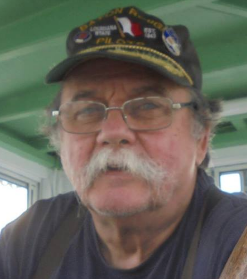The riverboat captain is a storyteller. Captain Don Sanders shares the stories of his long association with the river — from discovery to a way of love and life. This a part of a long and continuing story.
By Capt. Don Sanders
Special to NKyTribune
During a series of trips beginning this past week, 55 years ago, the DELTA QUEEN covered the Mississippi River from New Orleans, Memphis, St. Louis, Hannibal, and all points in between.
On Monday, 16 March 1970, the QUEEN left Memphis downbound for the Crescent City at noon. Capt. Howard Tate stood the front pilot’s watch — 6 a.m. to noon; 6 p.m. to midnight — with Captain Ernest E. Wagner, Master. Captain Carroll Shelby “Rip” Ware piloted on the back watch with Capt. Clarke “Doc” Hawley, the Officer in Charge in Wagner’s absence. On Captain Wagner’s shift, I was the unlicensed 2nd Mate in training after four years’ absence from the QUEEN while serving in the U. S. Air Force.

By 6 p.m., the QUEEN passed Friar Point Light, Mile 652.6. In my handprinted log entry, I noted that we’d made 83.4 miles with an average speed of 13.9 mph. Judging by automobile standards in the age of jet aircraft, less than 14 mph doesn’t seem very fast, but comparing this speed to those before the age of steam revolutionized human travel, nearly 14 miles in one hour, is zipping right along. Although not built for sprinting, the DELTA QUEEN occasionally topped 20 mph on swifter currents during similar six-hour watches.
Looking at the more than half-a-century-old logbook, I notice the distinctive handwriting of each entry and try to figure out who wrote them. Instantly, of course, I know mine. Captain Doc Hawley’s perfectly formed printing remains a classic example of the handwritten word. Only Captains Roddy Hammett and John Hartford had outstanding hand lettering like Cap’n Doc’s. The other three gentlemen on watch, Captains Wagner, Tate, and Ware, also had access to the logbook.
Usually, I can distinguish “Big Cap’s” writing, but not Tate’s or Ware’s script if removed from the times they stood watch. Seeing their handwriting, although all have long departed the Earth, I can see each man, hear their voices, and remember their mannerisms as they went about their business in the pilothouse of the DELTA QUEEN.

On Tuesday, 17 March, the DELTA QUEEN landed for nearly nine hours alongside the SPRAGUE, the largest steam towboat ever built, as it lay on the Yazoo Diversionary Canal at Vicksburg, Mississippi, the decisive Civil War siege and battlefield site. Late that night, before midnight, the QUEEN tied up opposite Natchez, Mississippi, on the Vidalia, Louisiana side of the river. There she stayed 13 hours while most passengers enjoyed touring the stately antebellum mansions of Natchez. During the intervening period, most crew members found their way to the Under-the-Hill Saloon in the old quarter on Silver Street.
By 10 a.m., Thursday, March 19, the DELTA QUEEN tied off at the Beinville Street Wharf in New Orleans. Though I cannot recall exactly, I’m confident that I was on the steamer’s bow as the QUEEN landed. Unbeknownst to me, Captain Hawley accepted the Alternate Captain’s position on the Steamer BELLE of LOUISVILLE, in Louisville, at the Falls of the Ohio River. As I later understood, Cap’n Wagner accelerated my experiences with the venerable steamboat DELTA QUEEN, preparing me to assume Captain Hawley’s place far quicker than I ever expected.
The next day, Friday, 20 March 1970, the DELTA QUEEN left New Orleans for Memphis at noon. What is oddly different about the logbook is that these two separate, distinct cruises are titled “Memphis — New Orleans — St. Louis.” From New Orleans to Memphis, the DELTA QUEEN made only a short stop at Bayou Sara near St. Francisville for an hour and another below Memphis to put the Volkswagen Bug ashore with Assistant Steward Bill Brown. The log noted that Mr. Brown “left for the Army.”

Natchez, Mississippi, sitting high on the loess bluffs, passed astern at 5:02 a.m. on Sunday, 22 March, and Vicksburg slid by the starboard bow at 4:11 that afternoon. At 6 p.m., the QUEEN passed abreast of Kate Adams Light, Mile 447.1, and Stack Island Lower, 487.0 at midnight – a distance of 39.9 miles run at 6.65 mph against the current of the mighty Mississippi River.
The current of the Mississippi River varies in speed for several reasons. Above Baton Rouge, the current naturally slows, allowing the DELTA QUEEN to vary her speed in either direction. High water from tributaries above significantly alters the Lower River’s flow, especially the Ohio and the Missouri Rivers, the great river’s chief contributors. Only once did I witness the DELTA QUEEN completely stall out while plowing headlong into the current of that greatest of North American rivers – at Corregidore Point during one trip in the spring during the early 1970s. The delay lasted only a few minutes until the QUEEN grasped a fresh breath of steam and broke free of the grip of the surging current.
Another time, a more comical event that grasped the DELTA QUEEN occurred in the strong current off the mouth of the Big Black River. The QUEEN had been slowly but steadily shoving into the current stream on a bright sunny morning with Captain Howard “Towline” Tate at the “sticks,” as we say, for the DELTA QUEEN has no steering wheel, but rather two horizontal, parallel steering levers, or “sticks.” I had just arrived in the pilothouse and noticed that Cap’n Tate was operating them in the usual way with the vessel moving according to the pilot’s guidance. About then, Captain Ernest E. Wagner came unannounced up the steep pilothouse steps. I noticed a slight grin on his face as he asked:

“How’s everything going, Captain Tate?”
“Oh, everything’s doing mighty fine,” Tate replied.
“No, it’s not,” Wagner shot back. “You’re hard aground. Put her on a straight rudder and step aside and look ashore. See? She’s pivoted on the bow and you’re steering the rest of the DELTA QUEEN back and forth, thinking you’re coming ahead.”
Indeed, the steamboat was firmly stuck, and inexplicably, Tate, a veteran pilot with years of experience on the Lower Mississippi River, had failed to recognize his predicament. For a steamboat pilot, few situations are more embarrassing than grounding a vessel in waters that should be navigable. But Captain Tate’s humiliation was compounded by his ignorance of the situation. Worse still, the Skipper caught him off guard and ribbed him about his unawareness that the DELTA QUEEN had run aground.
On Monday, March 23, from 10:45 to 10:50 a.m., the DELTA QUEEN conducted a short Fire and Boat Drill according to Captain Hawley’s impeccable script. Twenty-four hours later, Tuesday the 24th, the QUEEN passed Mhoons Landing with 16 ½ feet on the guage on a rising river. At 6:40 p.m., the steamboat tied up to the floating wharfboat belonging to Waterways Marine at the foot of Beale Street, Memphis. Seven hours later, the QUEEN backed away from Waterways and continued upstream.
Sunday, 25 March 1970, saw the DELTA QUEEN at Cedar Point Upper Light, Mile 760, at 6 a.m. and Island 26, Mile 799.5, at noon. She gained 39 ½ miles at an average speed of 6.6 mph. As we neared Booth Point, the piers for a new bridge, completed six years later and named the Caruthersville Bridge, stood like dark, foreboding sentinels in the threatening waters. My inscription in the log noted, “Stormy. Cold front passage.” I still recall the anguish I experienced as the DELTA QUEEN plowed closer into the deepening, angry weather ahead.

Suddenly, a horrific clamor exploded outside the window next to the Lazy Bench in the pilothouse where I sat, as a lightning bolt struck the live steamline running directly from the boilers to the QUEEN’s three-chime Lunkenheimer steam whistle. Thankfully, the enormous eruption was the thunderclap following the lightning strike, and nothing worse. The electrical charge followed the steam line, through the boilers, into the hull, and dissipated into the river without further distress.
The following day, Monday, 26 March, saw New Madrid, Missouri, at 2:20 a.m. and Hickman, Kentucky, at 7:30 p.m. At half-past noon, Cairo, Illinois, where the Ohio River joins the upper and Lower Mississippi Rivers, passed. At midnight, the last day of the long voyage from New Orleans began at Birmingham Light, Mile 76 UMR, with Grand Tower, forty minutes later, and Chester Bridge at 5:10 a.m. At noon, the DELTA QUEEN, averaging a respectable 6.6 mph, found herself at Bushburg Light, Mile 154.2. At 4 p.m., Captain Rip Ware simply noted: “Landed St. Louis.”
The next three days saw the DELTA QUEEN on a pilgrimage to the boyhood home of Mark Twain at Hannibal, Missouri. Captains Johnnie Graham and Ray Fugina piloted the QUEEN that trip. On April Fool’s Day, the boat departed St. Louis for New Orleans with a stop at Vicksburg, where the DELTA QUEEN again tied alongside the SPRAGUE. With an immediate turnaround in the Crescent City, the QUEEN retraced her path to St. Louis and another New Orleans round trip.
Returning to the Gateway City, another Hannibal excursion departed on 17 April with a full complement of 192 passengers. Again, pilots Fugina and Graham replaced Tate and Ware in the pilothouse. On Sunday, 19 April 1970, Captain Doc Hawley logged the passage of the DELTA QUEEN through Lock and Dams Number 24 and 25. That afternoon, soon after the QUEEN landed in St. Louis, Captain Doc told me he was leaving the DELTA QUEEN for the BELLE of LOUISVILLE.
After Captain Hawley cleared the boat, Captain Wagner called me to his room, informing me that I would take Captain Hawley’s position on the after-watch and act as an unlicensed First Mate until I tested and received my own Coast Guard certificate. To cover the law, an extra licensed man stayed aboard the vessel “carrying the license” while I performed the duties on the watch opposite the Master. Within two months, however, I earned my license as “Mate of Steam and Motor Vessels of All Gross Tons Upon Rivers.” But that’s a tale for another time.
 Captain Don Sanders is a river man. He has been a riverboat captain with the Delta Queen Steamboat Company and with Rising Star Casino. He learned to fly an airplane before he learned to drive a “machine” and became a captain in the USAF. He is an adventurer, a historian and a storyteller. Now, he is a columnist for the NKyTribune, sharing his stories of growing up in Covington and his stories of the river. Hang on for the ride — the river never looked so good.
Captain Don Sanders is a river man. He has been a riverboat captain with the Delta Queen Steamboat Company and with Rising Star Casino. He learned to fly an airplane before he learned to drive a “machine” and became a captain in the USAF. He is an adventurer, a historian and a storyteller. Now, he is a columnist for the NKyTribune, sharing his stories of growing up in Covington and his stories of the river. Hang on for the ride — the river never looked so good.
Purchase Captain Don Sanders’ The River book

Capt. Don Sanders The River: River Rat to steamboatman, riding ‘magic river spell’ to 65-year adventure is now available for $29.95 plus handling and applicable taxes. This beautiful, hardback, published by the Northern Kentucky Tribune, is 264-pages of riveting storytelling, replete with hundreds of pictures from Capt. Don’s collection — and reflects his meticulous journaling, unmatched storytelling, and his appreciation for detail. This historically significant book is perfect for the collections of every devotee of the river.
You may purchase your book by mail from the Northern Kentucky Tribune — or you may find the book for sale at all Roebling Books locations and at the Behringer Crawford Museum and the St. Elizabeth Healthcare gift shops.
Click here to order your Captain Don Sanders’ ‘The River’ now.





















Don, Your stories are great! I always enjoy reading about the adventures and personal on the Delta Queen! Memories are priceless!!! Thank you! Alice
Another great read Cap. I sure do miss those days.
Oh my,the days come alive in Capt Don’s fine telling of a busy steamboat season .This is made all the more poignant knowing at the end of 1970 she was met with dirges & wild fanfare both as folks were begging Congress to” Save the Queen”. I’ve felt her rub bottom & even be aground but never without the pilot knowing. I’ve felt swells slap her til you almost thought mini ocean .Capt Don’s telling brings all that & the day to day business & men who made it happen come to life . Thank you NkyTribune for giving him the place to capture us all in these journeys. I can’t wait to hear about the license testing.
Love your Sunday posts, always taking us along on your historic adventures. Thanks for the ride
These Delta Queen stories continue to fascinate me since I saw her so many times as a kid growing up on the Ohio River in Aurora. The Sprague as well as many other boats mentioned often by the Captain cause me to recall those childhood days as my brother and I watched them. Thank you for the informative and most delightful stories. They are all well told!
Wayne Smith in Huntsville, Alabama
Thanks for the ride today. Having been up and down that stretch only a few times, I could see in my minds eye some of what you described. Though not fully aground, I have felt her rub a couple times . Oh, to travel on her again. . .